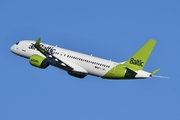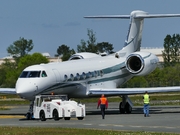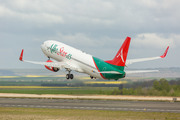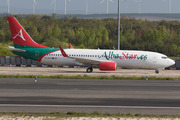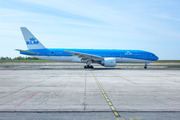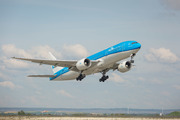Dépêches
Dassault Aviation Evaluates Laminar Designs in Flight as part of Europe's Clean Sky Research Program
Dépèche transmise le 26 janvier 2011 par PRNewswire
SAINT-CLOUD, France, January 26, 2011 /PRNewswire/ -- Dassault Aviation recently performed a successful flight test to evaluate potential applications of a laminar wing for large business jets. The flight was performed with a Falcon 7X at Dassault's Flight Test Center in Istres, France. The tests are part of the "Smart Fixed Wing Aircraft", one of the Integrated Technology Demonstrators of the European Clean Sky initiative. Clean Sky, one of Europe's largest research initiatives ever, aims to develop technologies for cleaner and quieter next-generation aircraft which will enter service beyond 2020.
The flight evaluated a new infrared (IR) camera technology, developed by FLIR, which is capable of measuring temperature gradients in high altitude/low temperature and pressure environment. The camera measured differences in surface temperatures between laminar and turbulent areas of the horizontal tail plane on the Falcon 7X. While the Falcon 7X is not based on a laminar design, at high altitudes a laminarity of up to 40% was predicted on the upper surface of the horizontal tail. Measurements from the IR camera placed at the top of the vertical tail were performed to provide experimental validation.
"The results, which are still under analysis by Dassault Aviation and ONERA, (the French national aerospace research center) do show laminar extensions as expected," said Philippe Rostand, Future Falcon Programs Project Manager. "The tests also permitted us to qualify new measurements techniques and equipment that will be used in future test flights to be flown by Dassault, Airbus and the other European partners on an even larger scale, such as the 'smart laminar wing' that will be flight tested in 2014 on a modified Airbus A340-300 test aircraft."
Among other aerodynamic innovations, a laminar wing offers the largest potential for a dramatic decrease in drag. Laminar wings are currently only used on sail planes and small business jets. Initial studies indicate a potential 5-10% drag decrease and corresponding reduction in fuel burn and CO2 emissions with a laminar wing design on a large aircraft. Demonstrations and analysis on a larger scale have yet to be performed to confirm possible efficient and safe application on larger aircraft.
Dassault Aviation previously performed a series of successful test flights with an experimental laminar airfoil from 1986-1989 on a modified Falcon 50. "Today, better measurement tools and production methods are in place to implement what we've learned so that we can someday bring these exciting findings into reality," said Rostand.
About Clean Sky
The Clean Sky initiative aims to develop cleaner and quieter aircraft in order to establish an innovative and competitive Air Transport System. It is built upon 6 different technical areas called Integrated Technology Demonstrators (ITDs): Smart fixed wing aircraft; green regional aircraft; green rotorcraft; sustainable and green engines; systems for green operations; eco-design. In addition, the Technology Evaluator (TE) will be used to assess the impact of all innovations from subsystem up to global level. Clean Sky will assess, design, build and test many technological validation vehicles that will give the industry greener, more innovative and competitive aviation products. Clean Sky is one of the largest European research initiatives ever, with a budget estimated at EUR1.6 billion over seven years, of which half is contributed by the European Commission in cash and half by the European Aeronautics industry, in kind. This public-private partnership will speed up technological breakthroughs to be introduced in future aircraft fleet.
About Dassault Falcon
Dassault Falcon is responsible for selling and supporting Falcon business jets throughout the world. It is part of Dassault Aviation, a leading aerospace company with a presence in over 70 countries across five continents. Dassault Aviation produces the Rafale fighter jet as well as the complete line of Falcon business jets. The company has assembly and production plants in both France and the United States and service facilities on multiple continents. It employs a total workforce of over 12,000. Since the rollout of the first Falcon 20 in 1963, 2,000 Falcon jets have been delivered to 67 countries worldwide. The family of Falcon jets currently in production includes the tri-jets-the Falcon 900EX, 900LX, and the 7X-as well as the twin-engine 2000LX.
For further information, please visit http://www.cleansky.eu Or contact: Helene BARBIER, Communication Officer Tel: +32-2-221-81-59 [email protected] Press Contacts Dassault Aviation (France) Vadim Feldzer, Tel. +33-1-47-11-44-13 Marie-Alexandrine Munoz, Tel. +33-1-47-11-64-23 Dassault Falcon (USA) Ralph Aceti, Tel. +1-201-541-45-85 Andrew Ponzoni, Tel. +1-201-541-45-88 Photos Hi Res Photos are available at: http://www.falconphotogallery.com USER ID: dassault - PASSWORD: falcon
CONTACT: For further information, please contact: Helene BARBIER,Communication Officer, Tel: +32-2-221-81-59 ;Press Contacts: Dassault Aviation (France), Vadim Feldzer, Tel.+33-1-47-11-44-13, Marie-Alexandrine Munoz, Tel. +33-1-47-11-64-23;Dassault Falcon (USA), Ralph Aceti, Tel. +1-201-541-45-85 , Andrew Ponzoni,Tel. +1-201-541-45-88
- 24/04Ibis Styles London Heathrow : l'hôtel géré par un passionné d'aviation pour les passionnés d'aviation (photos + vidéos)
- 23/04 SkyUp renouvelle son partenariat avec Wizz Air
- 23/04 Play : résultats de mars 2024
- 23/04 Les garde-côtes japonais commande trois Airbus H225 supplémentaires
- 23/04 Vueling et Make-A-Wish France signent un partenariat
- 23/04 TUI annonce ses destinations au départ de Deauville pour l'été 2024.
- 23/04 Twin Jet renforce son programme de vols sur la ligne Toulouse/Rennes
- 23/04 Norse Atlantic Airways : résultats du mois de mars 2024
- 23/04 Volotea renforce son offre entre Lille et le Maroc
- 22/04 Finnair a dévoilé son programme de vol pour les saisons hiver 2024 et été 2025
- 22/04 Qatar Airways annonce le lancement de vols à destination de Kinshasa
- 22/04 Vietnam Airlines et CAE prolongent leur accord
- 22/04 Mermoz Academy de Tours commande des Tecnam P-Mentor
- 22/04 Transavia France reçoit son 2e Airbus A320neo
- 20/04 Friedrichshafen 2024 : Blackwing présente un nouveau modèle de son BW650RG
- 20/04 Friedrichshafen 2024 : JMB Aircraft présente son Phoenix
- 19/04 Friedrichshafen 2024 : le projet "Fly To The North"
- 19/04 Friedrichshafen 2024 : Aura Aero présente pour la première fois ses trois appareils
- 19/04 Friedrichshafen 2024 : Duc Hélices présente son hélice Tiger-3
- 19/04 Friedrichshafen 2024 : Splash-in Aviation expose son Pétrel X


